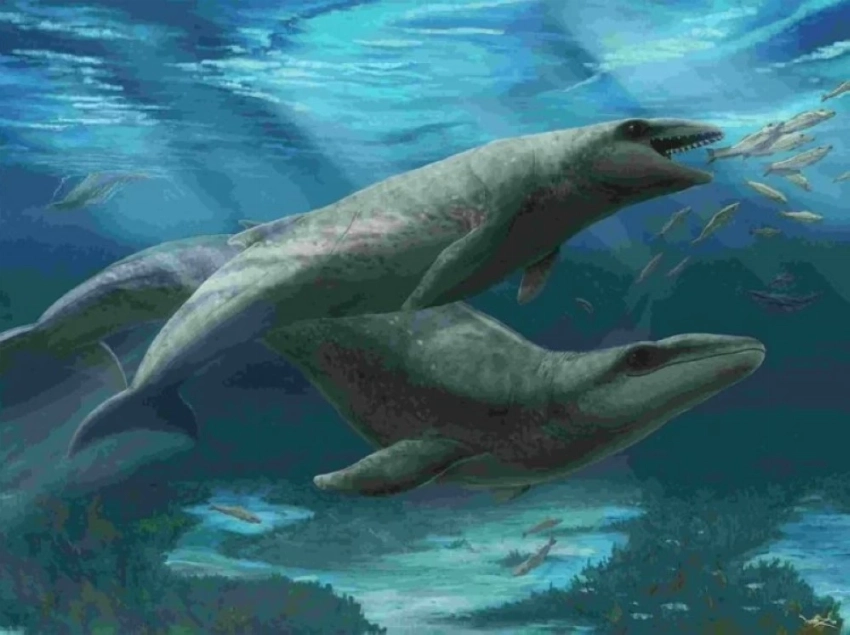غيّر الفهم عن تطور الحيتان.. علماء يكشفون عن «وحش المحيطات القديمة» – أخبار السعودية – كورا نيو

كشف فريق من علماء الحفريات الأستراليين عن بقايا متحجرة كاملة نسبياً لنوع جديد تماماً من الحيتان البدائية، عُثر عليها على سواحل ولاية فيكتوريا جنوب شرق أستراليا، في واحدة من أبرز الاكتشافات العلمية لهذا العقد، مما يعيد صياغة فهم العلماء لمسار تطور هذه الكائنات العملاقة.
ويعود الاكتشاف الذي نُشرت تفاصيله في مجلة «Zoological Journal of the Linnean Society »وهي مجلة مرموقة للأحياء الشعاعية إلى حوت عاش قبل أكثر من 26 مليون سنة، في حقبة الأوليغوسين، ويتميز بأنياب حادة طويلة وجسم عضلي يشير إلى أنه كان مفترساً شرساً في قمة السلسلة الغذائية البحرية آنذاك.
الكائن الجديد، الذي أُطلق عليه اسم علمي مبدئي «Janjucetus dullardi» (حوت جاك اللامع)، يبلغ طوله حوالي 5 متر فقط لأنه كان صغيراً في السن، وهو أصغر بكثير من الحيتان الحديثة، لكنه كان يمتلك أسناناً مخروطية حادة قادرة على تمزيق فرائس كبيرة، بما في ذلك أسماك القرش والحبار العملاق والثدييات البحرية الأخرى.
يعيد فهم عمالقة البحار
ووفقاً للفريق العلمي فإن الصفات التي كان يتمتع بها هذا الحوت تجعله مختلفاً جذرياً عن الصورة التقليدية التي رسخها العلم للحيتان البدائية ككائنات صغيرة تشبه الغزلان المائية أو ذوات أسنان بدائية ضعيفة.
وقال الدكتور إريك فيتزجيرالد، قائد فريق البحث في متحف فيكتوريا: «كنا نعتقد سابقاً أن الحيتان انتقلت بسرعة من الحياة البرية إلى أسلوب حياة يعتمد على تصفية العوالق، لكن هذا الحوت الجديد يثبت أن هناك فرعاً طويل الأمد من الحيتان المفترسة ذات الأسنان الكبيرة استمر لملايين السنين، وهو ما يعيد ترتيب الشجرة التطورية للحيتان بشكل جذري».
6 سنوات من البحث والتحليل
الاكتشاف يعود إلى يونيو 2019 عندما عثر صياد هاوٍ على جمجمة بارزة في صخور شاطئ «Inverloch» شرق ملبورن، لكن التنقيب المنهجي الذي استمر 6 سنوات كشف عن هيكل عظمي شبه كامل محفوظ بطريقة نادرة داخل صخور رسوبية بحرية قديمة.
وأكدت التحليلات الجيوكيميائية أن هذا الحوت كان يسبح في مياه دافئة ضحلة قبالة القارة الأسترالية عندما كانت لا تزال متصلة جزئياً بأنتاركتيكا.
وتتجاوز أهمية الاكتشاف مجرد إضافة نوع جديد إلى السجل الأحفوري؛ فهو يملأ فجوة زمنية كبيرة في تاريخ تطور الحيتان، ويثبت أن الانتقال من الحيتان ذات الأسنان المفترسة إلى الحيتان الزرقاء العملاقة التي نعرفها اليوم لم يكن خطاً مستقيماً واحداً، بل تضمن فروعاً جانبية طويلة ومتنوعة، بعضها انقرض تماماً.
A team of Australian paleontologists has uncovered relatively complete fossil remains of an entirely new species of primitive whale, found on the shores of Victoria, southeastern Australia, in one of the most significant scientific discoveries of this decade, reshaping scientists’ understanding of the evolutionary path of these giant creatures.
The discovery, details of which were published in the journal “Zoological Journal of the Linnean Society,” a prestigious journal for ray-finned organisms, dates back to a whale that lived over 26 million years ago, in the Oligocene epoch. It is characterized by long, sharp tusks and a muscular body, indicating that it was a fierce predator at the top of the marine food chain at that time.
The new creature, initially named “Janjucetus dullardi” (the Shining Jack Whale), measures about 5 meters in length, as it was still young, making it much smaller than modern whales. However, it possessed sharp conical teeth capable of tearing apart large prey, including sharks, giant squid, and other marine mammals.
Revising the understanding of sea giants
According to the scientific team, the traits exhibited by this whale make it radically different from the traditional image established by science of primitive whales as small creatures resembling water deer or having weak primitive teeth.
Dr. Eric Fitzgerald, the leader of the research team at the Victoria Museum, stated: “We previously believed that whales quickly transitioned from land life to a lifestyle based on filter-feeding, but this new whale proves that there was a long-lasting branch of predatory whales with large teeth that persisted for millions of years, fundamentally rearranging the evolutionary tree of whales.”
6 years of research and analysis
The discovery dates back to June 2019 when a hobbyist fisherman found a prominent skull in the rocks of “Inverloch” beach east of Melbourne. However, systematic excavation over 6 years revealed a nearly complete skeleton preserved in a rare manner within ancient marine sedimentary rocks.
Geochemical analyses confirmed that this whale swam in warm shallow waters off the Australian continent when it was still partially connected to Antarctica.
The significance of the discovery goes beyond merely adding a new species to the fossil record; it fills a significant temporal gap in the history of whale evolution and demonstrates that the transition from predatory toothed whales to the giant blue whales we know today was not a straight line, but included long and diverse side branches, some of which became completely extinct.
المصدر : وكالات




